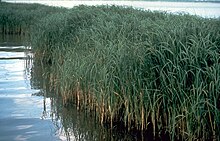Spartina alterniflora
| Spartina alterniflora | |
|---|---|
 |
|
| Scientific classification | |
| Kingdom: | Plantae |
| (unranked): | Angiosperms |
| (unranked): | Monocots |
| (unranked): | Commelinids |
| Order: | Poales |
| Family: | Poaceae |
| Genus: | Spartina |
| Species: | S. alterniflora |
| Binomial name | |
|
Spartina alterniflora Loisel. |
|
Spartina alterniflora, the smooth cordgrass,saltmarsh cordgrass, or salt-water cord grass, is a perennial deciduous grass which is found in intertidal wetlands, especially estuarine salt marshes. It grows 1-1.5 m tall (3-5 feet,) and has smooth, hollow stems which bear leaves up to 20-60 cm (8 inches-2 feet) long and 1.5 cm (1/2 inch) wide at their base, which are sharply tapered and bend down at their tips. Like its relative saltmeadow cordgrass S. patens, it produces flowers and seeds on only one side of the stalk. The flowers are a yellowish-green, turning brown by the winter. It has rhizoidial roots, which, when broken off, can result in vegetative asexual growth. The roots are an important food resource for snow geese. It can grow in low marsh (frequently inundated by the tide) as well as high marsh (less frequently inundated), but it is usually restricted to low marsh because it is outcompeted by saltmeadow cordgrass in the high marsh. It grows in a wide range of salinities, from about 5 psu to marine (32 psu), and has been described as the "single most important marsh plant species in the estuary" of Chesapeake Bay. It is described as intolerant of shade.
S. alterniflora is noted for its capacity to act as an environmental engineer. It grows out into the water at the seaward edge of a salt marsh, and accumulates sediment and enables other habitat-engineering species, such as mussels, to settle. This accumulation of sediment and other substrate-building species gradually builds up the level of the land at the seaward edge, and other, higher-marsh species move onto the new land. As the marsh accretes, S. alterniflora moves still further out to form a new edge. S. alterniflora grows in tallest forms at the outermost edge of a given marsh, displaying shorter morphologies up onto the landward side of the Spartina belt.
S. alterniflora is native to the Atlantic coast of the Americas from Newfoundland, Canada, south to northern Argentina, where it forms a dominant part of brackish coastal saltmarshes.
Spartina alterniflora can become an invasive plant, either by itself or by hybridizing with native species and preventing propagation of the pure native strain. One example of an invasive Spartina alterniflora hybrid is that of S. anglica. S. anglica is a fertile polyploid derived from the hybrid S.alterniflora × townsendii (S. alterniflora × S. maritima), first found when American S. alterniflora was introduced to southern England in about 1870 and came into contact with the local native S. maritima. S. anglica has a variety of traits that allow it to outcompete native plants, including a high saline tolerance and the ability to perform photosynthesis at lower temperatures more productively than other similar plants. It can grow on a wider range of sediments than other species of Spartina, and can survive inundation in salt water for longer periods of time. S. anglica has since spread throughout northwest Europe, and (following introduction for erosion control) eastern North America.
...
Wikipedia
